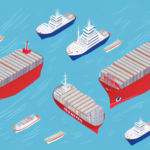Understanding the Impact of Wharfage on Supply Chain Management
The logistics industry is one of the most complex and intricate ecosystems in the economy. The amount of work and coordination required to move goods and commodities from point A to point B is monumental. One critical factor in the supply chain is the role of wharfage. Wharfage refers to a fee or tax charged by ports and harbors for the use of their facilities. This charge is based on the weight or value of the cargo and is an additional cost borne by transportation companies, importers, or exporters. Understanding how wharfage impacts the supply chain is essential, as it can have far-reaching implications for transportation costs, customs clearance, and inventory management.
What is Wharfage and How Does it Affect Supply Chain Management?
Wharfage is a fee charged for the utilization of a port's infrastructure such as piers, docks, and warehouses. These facilities are critical for the movement of cargo from ships to land transport, and vice versa. Wharfage is an additional cost on top of ocean freight and can vary based on factors such as the type of cargo, weight, and volume. As a significant expense, wharfage can impact transportation costs, causing fluctuations in the overall supply chain's efficiency. Hence, understanding its effects is crucial for businesses.
Wharfage adds complexity to the logistics process. Businesses must factor in these costs when calculating overall transportation expenses, which is challenging when dealing with multiple ports and various types of cargo. Additionally, wharfage fees can vary significantly between ports, making it difficult to compare costs and choose the most cost-effective option.
Furthermore, wharfage fees are not always transparent. Some ports may charge additional fees for services such as container handling or customs clearance, which can accumulate quickly. This lack of transparency complicates accurate budgeting and future planning for businesses.
The History of Wharfage and Its Role in the Global Supply Chain
Wharfage has existed since ancient times as a means of generating revenue for the maintenance of ports and harbors. With the globalization of the economy, the role of wharfage expanded, becoming essential in the global supply chain. Factors such as tariffs, international trade agreements, and transportation regulations have influenced wharfage fee structures. Typically, wharfage is levied on a wide range of commodities, including essential goods like food and medical supplies.
One of the key challenges facing the wharfage industry today is balancing revenue generation with environmental sustainability. Many ports are implementing green initiatives to reduce their carbon footprint and minimize environmental impact. This includes using renewable energy sources like wind and solar power and adopting eco-friendly practices such as waste reduction and recycling.
Another significant trend is the increasing use of technology to improve efficiency and streamline operations. Automated systems for cargo handling and tracking, as well as digital platforms for communication and collaboration among supply chain stakeholders, are becoming commonplace. These technological advancements help reduce costs, improve safety, and enhance the overall customer experience for businesses relying on wharfage services.
How Wharfage Fees are Calculated and Who Pays Them
Wharfage fees are calculated based on various factors, including the weight, volume, and value of the goods being transported. These fees vary from port to port and are typically paid by transportation companies, importers, or exporters. In some cases, the fees may be passed on to the end consumer through the product's price. It's important to note that wharfage fees are often subject to change, and fluctuations in tariffs and regulations can alter the fee structure.
The type of cargo also affects wharfage fees. For instance, hazardous materials may incur higher fees due to the additional safety measures required during handling and storage. Similarly, oversized or overweight cargo may necessitate special equipment or handling procedures, resulting in higher fees.
Additionally, wharfage fees are not the only charges associated with port operations. Other fees may include terminal handling charges, customs fees, and storage fees. These can accumulate quickly, especially for companies transporting goods through multiple ports.
The Impact of Wharfage on Transportation Costs and Delivery Times
Wharfage fees present significant challenges for global supply chains. These charges can add considerable costs to transportation and logistics, impacting the final delivery price of goods. This is especially true for low-value goods, where the proportion of wharfage fees to overall costs is higher. Moreover, wharfage can lead to delays in the delivery of goods as ports become congested, slowing the movement of cargo in and out of facilities. These impacts can ripple through the entire supply chain, affecting consumer prices and inventory management. Therefore, minimizing wharfage fees is essential for businesses.
One way to minimize wharfage fees is to optimize transportation routes. By selecting ports that are less congested or have lower wharfage fees, businesses can reduce transportation costs and delivery times. Another strategy is to negotiate with port authorities for lower fees or explore alternative transportation methods, such as rail or air freight, which may be more cost-effective.
Staying up-to-date on changes in wharfage fees and regulations is also crucial. Ports may increase fees or alter their policies, significantly impacting transportation costs and delivery times. By staying informed and adapting to these changes, businesses can better manage their supply chains and minimize the impact of wharfage fees.
Strategies for Minimizing Wharfage Fees in Supply Chain Management
To minimize wharfage fees, businesses should explore a variety of strategies:
- Container Consolidation: Combining multiple consignments into a single shipment can reduce transportation and wharfage costs.
- Technology Adoption: Utilizing technologies like artificial intelligence, machine learning, and transportation management systems can optimize loading and unloading processes, minimize handling costs, reduce waiting times, and speed up delivery times.
- Route Optimization: Selecting ports with lower fees and less congestion can help lower costs and improve efficiency.
- Negotiation: Engaging with port authorities to negotiate lower fees can lead to significant savings.
- Alternative Transportation Methods: Exploring options like rail or air freight may offer more cost-effective solutions.
The Relationship between Wharfage and Customs Clearance
Customs clearance is a critical aspect of supply chain management, and understanding its relationship with wharfage is essential. Wharfage fees often coincide with customs clearance processes, as both are integral components of importing and exporting goods. If a shipment is not declared correctly, it can lead to additional fees and charges, resulting in delays. Ensuring compliance with customs regulations is therefore essential to minimize fines, charges, and delays.
The Influence of Wharfage on Inventory Management
Wharfage fees significantly impact inventory management. These fees affect transportation costs and delivery times, leading to fluctuations in inventory levels. Rising prices or longer delivery times can result in inventory shortages, impacting other supply chain aspects. Therefore, businesses must have a robust inventory management system that accurately tracks inventory levels, predicts supply and demand, and prevents shortages.
Innovations in Technology that are Transforming Wharfage Operations
Technological innovations are transforming wharfage operations. Technologies such as automation, robotics, and blockchain are revolutionizing logistics operations. Automation and robotics reduce handling costs, improve efficiency, and enhance safety. Blockchain technology ensures that shipping and cargo information is transparent and secure, enhancing the speed and accuracy of customs clearance processes, reducing fraud and errors, and improving supply chain traceability. These technologies help businesses optimize wharfage operations and minimize costs.
Best Practices for Managing the Impact of Wharfage on Supply Chain Management
Effective management of wharfage's impact on supply chain management involves several best practices:
- Regular Cost-Benefit Analysis: Evaluate wharfage fees and associated costs regularly to identify savings opportunities.
- Selective Port Usage: Choose ports that offer lower fees and higher efficiency.
- Reduce Port Usage: Minimize the number of ports used to decrease cumulative fees.
- Alternative Transportation: Utilize rail or road transportation to lessen reliance on ports and maritime transport.
- Relationship Building: Foster strong relationships with logistics service providers and customs officials to reduce delays and improve compliance.
Case Studies: Examining Real-World Examples of Wharfage's Impact on Supply Chains
Several real-world case studies illustrate the significant impact of wharfage on supply chains:
- Philippines: The Department of Transportation and the Department of Finance implemented policies to streamline and standardize wharfage fees. This policy reduced fees and increased efficiency in customs clearance processes.
- Australia: The Port of Brisbane introduced a multi-level automated terminal that reduced waiting times and optimized the unloading and loading process, thereby lowering wharfage costs.
These case studies highlight the importance of implementing effective wharfage management strategies to enhance supply chain efficiency.
Future Outlook: Predictions for the Future Role of Wharfage in Global Trade
The future role of wharfage in global trade is poised to evolve with ongoing technological advancements and increasing globalization. Wharfage will continue to play a significant role in logistics and supply chain management, but its impact will be influenced by regulatory frameworks and tariffs. Factors such as policy changes, technological innovations, and market dynamics will shape the future impact of wharfage on global trade.
Conclusion: Summarizing the Key Takeaways About Understanding the Impact of Wharfage on Supply Chain Management
In conclusion, understanding the impact of wharfage on supply chain management is vital for businesses aiming to optimize logistics operations and minimize costs. Wharfage affects transportation costs, delivery times, and inventory management significantly. Strategies like container consolidation and adopting new technologies can help reduce wharfage fees. Building strong relationships with logistics service providers and customs officials can enhance compliance and reduce delays. The future role of wharfage in global trade will depend on technological advancements, market forces, and regulatory developments.




















